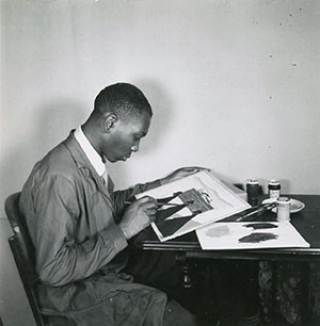Born 1917, Atlantic City, New Jersey
Died 2000, Seattle, Washington
Jacob Lawrence’s family arrived in New Jersey as part of the “Great Migration,” the mass exodus of African Americans from the South. Lawrence showed an aptitude for painting as a child, then moved to Harlem in 1930, where he encountered a vibrant art community, albeit one affected by the onset of the Great Depression. He trained at the Harlem Art Workshops funded by the FAP, where his mentor, Charles Alston, sought to encourage him without blunting his already evident untutored sensibility. Lawrence painted for the easel division of the FAP between 1938 and 1939, rising to national prominence by the early 1940s.
Lawrence is known for multipanel series that tell stories of African and African American history, subjects encouraged by Harlem’s intelligentsia. His Migration series (1940–1941), using montagelike sequencing and appended captions, depicts the movement that brought the artist’s own family to the Northeast. Based on resources at the Schomburg Center for Research in Black Culture, Lawrence outlined sixty scenes and methodically painted the entire series one color at a time to produce a unified flow of images. After its debut at the Downtown Gallery in 1941, MoMA and the Phillips Collection each agreed to purchase half of the series, divided between even- and odd-numbered panels. Because of his use of flat, simplified forms and highly patterned compositions, Lawrence was often associated with self-taught African American artists such as Horace Pippin. But his distinctive style drew knowingly on cubist geometry and the simplicity of Sienese landscapes of the early Renaissance.
Lawrence also painted individual genre scenes set in Harlem and the South. Blind Beggars, created under the auspices of the FAP easel division, exemplifies the type of populist realism advocated by Holger Cahill, the program’s director. Using his preferred medium of gouache, Lawrence documented everyday life through a carefully orchestrated play of shape and dense, matte color. His paintings Catholic New Orleans and Rampart Street were first shown at the Downtown Gallery, the latter as part of American Negro Art: Nineteenth and Twentieth Centuries (1941–1942).
Jenevive Nykolak
Dickerman, Leah, and Elsa Smithgall. Jacob Lawrence: The Migration Series. New York: The Museum of Modern Art, 2015.
Hills, Patricia. Painting Harlem Modern: The Art of Jacob Lawrence. Berkeley: University of California Press, 2010.
